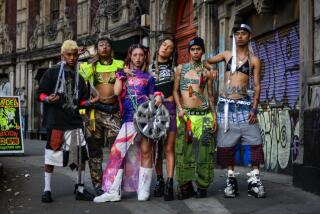Designers in the Driver’s Seat : Innovative Southland Firms Are Having a Profound Influence on the Shape of the Auto’s Future
- Share via
Charles W. O. Ellwood, an English-born car designer who has spent most of his career in Germany, had an epiphany of sorts when he arrived in Southern California last October to take the helm of Volkswagen’s design studio in Simi Valley.
The American motorist’s fascination with cup holders, he says, suddenly made sense.
“You can’t drive the speeds we drive in Europe and use cup holders; it’s just too dangerous,” says Ellwood, 39, former chief of interior design at Volkswagen in Wolfsburg, Germany. “But here, you’re living in the vehicle, you’re drinking in the vehicle, the kids are moving back and forth. You’re doing a lot of things other than driving.”
Car makers have been coming to similar realizations since they began flocking to the West Coast 20 years ago. From cup holders built into dashboards to the sleek coupes seen pulling out of driveways, the Southern California influence has been profound.
Although most auto designs are still produced in Detroit, Tokyo, Wolfsburg and other motor cities, “probably the best designs in the world are coming out of California” because the environment is conducive to creativity, says Jess Harder, chief designer at International Automotive Design in Huntington Beach.
The Miata two-seat ragtop was born in Mazda’s design studio in Irvine. Toyota designers in Newport Beach created the Previa minivan and the Lexus SC 300 and 400 models. Southern California studios also produced the 1993 Ford Probe and Chevrolet’s 1994 Camaro, models that revived sports coupe sales.
Today, 16 satellite studios and a handful of independent automotive design firms throughout the region are shaping the futures of General Motors, Ford, Volvo, BMW and Volkswagen, to name a few.
It was the expertise in seat design of Designworks/USA in Newbury Park that caught the attention of BMW in the late 1980s, says Charles W. Pelly, president of Designworks. The German auto maker has since purchased 60% of Designworks’ stock, and now accounts for a third of the studio’s business.
Volkswagen’s updated version of the classic Beetle, promised for delivery to dealers in 1998, was designed in Simi Valley. The company is hoping the new Beetle will catch the fancy of 21st Century drivers as the original did in the 20th.
Designers for other car makers are also under the gun to divine the whims of the next century. The stakes are monumental. To take a design from sketches to cars on the road can take more than five years and cost $1 billion or more. And American and European car makers, since losing market share to Japanese competitors in the 1980s, know they cannot afford to neglect a single nuance of design.
Thomas V. Peters, head of GM’s studio in Newbury Park, says flatly: “This is war.”
California, then, is a strategic battlefront. The state accounts for 10% of new car registrations in the United States each year and 3% of new registrations worldwide. To succeed in California, car makers have decided, it makes sense to be in California, where the sunshine shows off a car’s finish and reveals the flaws or grace of every curve, where car-crazy consumers are quick to embrace a fresh design and quicker to discard a stale one, and where trends seem to land like drops of water and ripple over the rest of the country.
Designers at local studios work in high-tech security buildings to guard against industrial spying. “Paranoia runs rampant,” said Ronald Powers, president of Powers Design International, an independent design firm in Newport Beach.
Designers furtively scour the Southern California landscape for hints of shifting consumer tastes, looking for clues in everything from computer terminals to electric mixers to athletic shoes.
“Our influences range from man-made to nature, American to international,” says Douglas Halbert, chief designer at Honda Research and Development in Torrance.
Some have adopted an academic approach. Volvo’s Camarillo design center, for example, employs a staff sociologist to track changes in consumer attitudes.
“This is a think tank,” says Sylvia S. Voegele, general manager at Volvo’s studio. “When we present a design, we also present who we think it would sell to and why.”
Designers say that working in Southern California gives them a dual competitive edge. Living amid the highest concentration of car enthusiasts in the world allows them to sense taste trends and driving amid the world’s largest variety of cars provides constant style inspiration.
When Tom Matano oversaw the design of the Miata, he pictured himself driving the car on Pacific Coast Highway from Laguna Beach up to Malibu. The RX7, also designed in Mazda’s California studios, was envisioned as a model that athletic types would drive to the gym for workouts.
Designers in New York and Tokyo--who take the train to work--would not have designed the kinds of cars that are popular in California, Matano says.
“Part of being a designer is being a visionary,” says Dave Hackett, general manager of Toyota’s Newport Beach design studio, which is the oldest of the Southern California studios. “Based on what we see today, we have to predict what people will want three to five years from now.”
Typically, the manufacturer will specify wheelbase and engine layout, then request a new design or an updating of a model already in production. As soon as the order arrives the designers commence sketching, and the weeding-out process begins. The designers compete with each other; studios compete with other studios within the company and with independent design studios. And, finally, the car makers compete in the marketplace.
Ford’s studio in Valencia has fared well in these contests. Hastily assembled in 1983 after GM had laid plans for its Newbury Park facility, the Ford studio produced a winner right away--the 1989 edition Thunderbird. Since then, the studio has had a string of successes, including major influence on the 1993 Probe. Sales of that sports coupe surged 42% from 1992.
But now, even Hutting acknowledges that Ford, the domestic design leader since it introduced the top-selling Taurus sedan in the mid-1980s, has surrendered the mantle to Chrysler, whose striking new line was developed at the Chrysler Pacifica studio in Carlsbad. Ford, Hutting says, must find ways to reassert itself.
One of the key challenges will be to anticipate trends in the minivan and sport utility vehicle markets, segments that barely existed a decade ago but last year accounted for 16% of Ford’s domestic sales (564,916 units).
Searching for clues to the future of these markets, Hutting and his design team are paying close attention to societal trends, such as the four-day work week. If that trend broadens, consumers may use vehicles less for commuting and more for leisure-time driving.
While Ford was turning heads with the Taurus, GM was turning stomachs with the Caprice, a whale of a car that went belly up on arrival. GM lost U.S. market share in the last decade but has had better luck with the 1994 Chevrolet Camaro, based largely on an aerodynamic Newbury Park design.
U.S. sales of the Camaro and its Pontiac Firebird sibling totaled 76,602 during the first five months of 1994, compared to 21,509 cars of the previous design during the equivalent period of 1993. “GM finally gets it,” says Gordon Wangers, an analyst with Vista-based Automotive Marketing Consultants Inc. “The Camaro could be a car that will turn GM around.”
Volkswagen has pinned similar hopes on the Concept One, the working name for a smooth, symmetrical successor to the Beetle.
U. S. Beetle sales peaked at 367,607 in 1969, but Volkswagen sales have fallen off the charts since 1977, when the last Beetle was sold in the United States.
Volkswagen spokeswoman Lana Ferrari says that since January, when the Concept One was unveiled at the Detroit auto show, the company has fielded 30,000 calls and collected 5,000 letters from VW fans urging the company to build the new Beetle.
For all its nostalgic appeal, the Concept One is no replica, says Ellwood, head of Volkswagen’s Simi Valley studio. The car is capable of running on electricity--an important capacity since California law requires that 2% of all vehicles sold in the state in 1998 be emissions-free. Unlike its predecessor, the Concept One has a front engine, front-wheel drive, anti-lock brakes, dual air bags and, of course, “cup holders front and rear,” Ellwood says with a chuckle. “We paid particular attention to that.”







